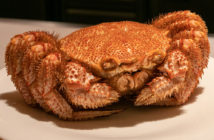Along with tempura and sukiyaki, sushi is one of the most recognized and beloved Japanese cuisines and can easily be spotted on the menus of Japanese restaurants all over the world. Sushi has become so popular worldwide, there are now many different and unique forms of
it, some of which are hardly recognizable
in Japan.
Kaiten-zushi Sushi train is a popular and inexpensive type of restaurant where plates of sushi are placed on a rotating conveyor belt that encircles the serving bar. Customers can simply pick their selections from the steady stream of fresh sushi as they pass by.
The origin of sushi began in the mountainous regions of Southeast Asia, where river fish were preserved using a form of fermentation in salt and rice, after which the rice was discarded. This method was brought to Japan through China and Korea and is the earliest form of sushi. The dish is today known as Nare-zushi (matured sushi). Since it took months to make Nare-zushi though fermentation, vinegar was later introduced as a substitute.
The use of vinegar in making sushi played a big role in developing a wide variety of sushi styles such as Haya/Oshi-zushi (quick/pressed sushi) and Nigiri/Edomae-zushi (hand-formed/Edo-style sushi), where rice and fish were eaten together as a main dish.
Haya/Oshi-zushi is made by layering vinegared rice and fish in a special wooden box.
Nigiri/Edomae-zushi was developed in the late Edo period. Edomae, now called Tokyo bay, was well-known for its abundant fisheries. Together with good soy sauce produced in nearby towns, white rice and fresh fish, Edomae-zushi became very popular among Edo people. The trend later spread to the areas of Kyoto and Kansai.
There are many good sushi restaurants in Sapporo. Among them is Sushi Miyakawa, the first and only three star sushi restaurant in Hokkaido. Its branch restaurant, Sushi Shin, has recently opened here in Niseko.
We had the privilege to interview the head sushi chef of Sushi Shin, Mr. Hironori Satake.
Mr. Satake was born and raised in Wakayama prefecture and enjoyed wrestling in high school. His mother was a chef and he became interested in cooking from helping her as a child. After high school, Mr. Satake’s uncle recommended he work for a sushi restaurant that he knew. Mr. Satake was so fascinated by the professionalism of the chefs that he decided to undertake an apprenticeship without hesitation.
His training days were quite tough; for the first 3 years he wasn’t allowed to handle food and he just did dishes, chores and cleaned. The many years of disciplined training have paid off and 30 years later Chef Satake is enjoying his profession more than ever.

What is the most important part of your job?
The key principles include focusing on our technique and ingredients to ensure our customers enjoy their dining experience.What was the hardest thing you experienced during your training days?
The early years were particularly challenging as I had to prove to the senior chefs that I truly possessed the commitment and desire to become a sushi chef. The training was demanding both mentally and physically.Being a sushi chef requires delicate handling. What is the most important thing in terms of hand forming sushi?
Experience and technique is required for this job, however I think the most important thing you need is passion and curiosity to bring out the best of the ingredients.
Finding the best ingredients can be challenging but thanks to the long standing relationships that myself and master chef Miyakawa have cultivated over the decades we are confident in our ability to source the finest ingredients available in Japan.Tell us about your hotel restaurant experience.
It was an opportunity to improve my skills and gain a deeper understanding and appreciation of international guests. Now at Sushi Shin I am working with our team to offer traditional Edo Mae Sushi to the growing number of foreign visitors.What made you want to work in Niseko?
Learning from master chef Miyakawa and experiencing the natural beauty of Niseko was too much of an opportunity to pass up.Did you come straight to Niseko from Tokyo?
Before opening in Niseko I trained directly under master chef Miyakawa at his restaurant in Sapporo.How did it feel to be an apprentice again after being an experienced and successful sushi chef?
Learning from and working closely with master chef Miyakawa is a great experience and honor. I believe that you can never stop learning throughout your lifetime.What is the most exciting thing about being a sushi chef?
We make and serve sushi in front of customers and I take real pleasure in this interaction. The sushi counter is similar to a private kitchen experience as the customers can communicate throughout the meal directly with the chefs.What are your plans now?
In keeping with the Edomae tradition, I would like our international customers to experience authentic traditional Edomae-zushi.
Together with master chef Miyakwa we are going to create sushi using Hokkaido’s exquisite seasonal ingredients. I also continue to focus on strengthening my relationship with our customers.What do you look forward to in launching “Sushi Shin” in Niseko?
“Sushi” is the traditional art of Japan. The basic principal of sushi is not only to maintain the freshness of the raw ingredients but to keep the rice at body temperature throughout the process. Following the traditional Edo-style, we aim to provide the highest level of hospitality and service to our guests from all over the world. Our goal is for customers to experience what we believe is truly world class Edo style sushi.
Contact www.sushishin.jp/ for enquiries




